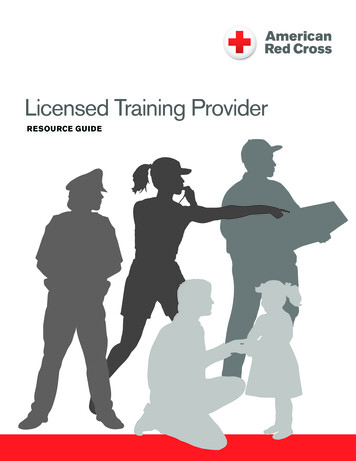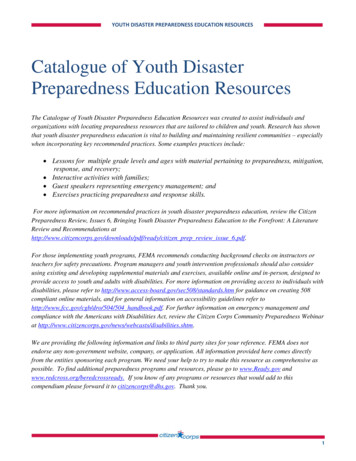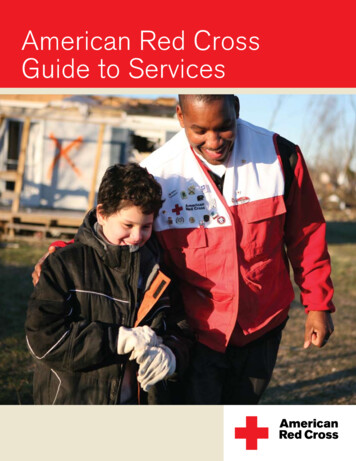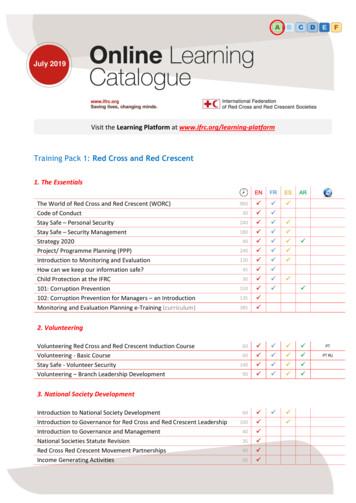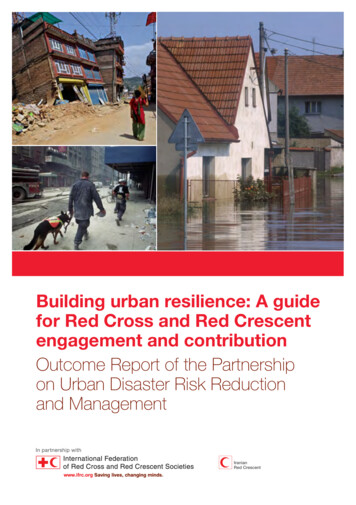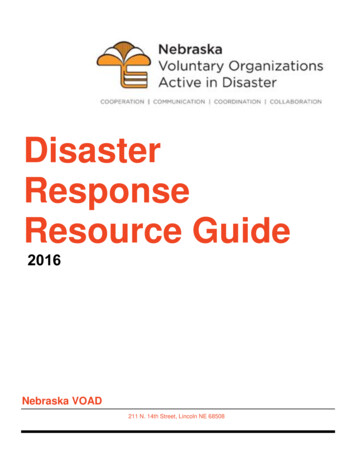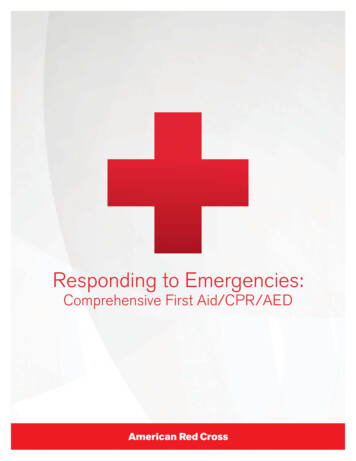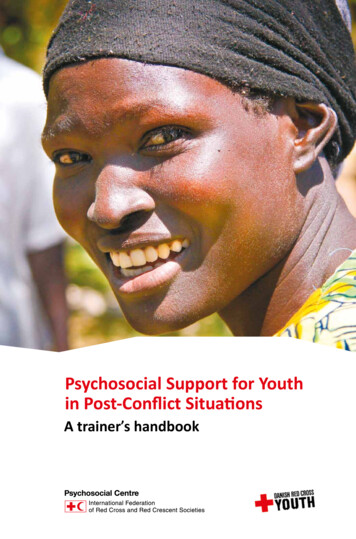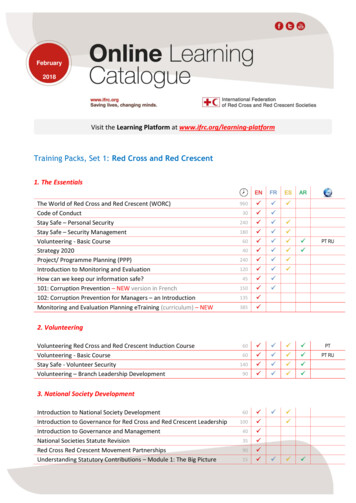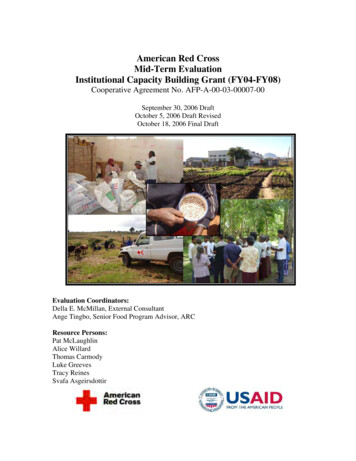
Transcription
American Red CrossMid-Term EvaluationInstitutional Capacity Building Grant (FY04-FY08)Cooperative Agreement No. AFP-A-00-03-00007-00September 30, 2006 DraftOctober 5, 2006 Draft RevisedOctober 18, 2006 Final DraftEvaluation Coordinators:Della E. McMillan, External ConsultantAnge Tingbo, Senior Food Program Advisor, ARCResource Persons:Pat McLaughlinAlice WillardThomas CarmodyLuke GreevesTracy ReinesSvafa Asgeirsdottir
ARC ICB Mid-Term Evaluation. October 18, 2006.iiExecutive Summary1.0. BackgroundThe goal of the American Red Cross’s (ARC) Title II Institutional Capacity Building(ICB) grant (FY04-08) is to improve the agency’s institutional and technical capacity todesign and manage food aid and nutritional interventions as an effective response toemergencies. The grant’s activities focus on achievement of two intermediate results(IRs): IR1: ARC improves its institutional and technical capacity to design and managefood aid and nutrition interventions as an effective response to emergencies and IR2: Red Cross/Crescent Movement partners develop the capacity to design andmanage food aid and nutrition interventions as an effective response toemergencies.Specifically, this ARC ICB program was originally designed and funded to: (1) refineARC’s existing systems and tools and develop new systems and tools for use in foodprogramming as a response to emergencies, (2) conduct a pilot program in two countriesfor the development and testing of systems and tools for use in executing and expandingfood programming, (3) disseminate the results of these pilots to Red Cross Movementpartners and beyond, and (4) expand and scale-up food programming to ARC bilateralprograms in other countries. A small sub-component that focused on promoting theimportance and need for food in international emergency responses was also included.The total budget for the ICB program is 2,716,112, of which 1,800,000 has beenawarded by USAID with a commitment from ARC of 916,112 (33 percent of the granttotal) in matching funds.This report presents the findings of the grant’s mid-term evaluation. The task ofassessing the this grant was complicated by the fact that the original M&E Plan wasdesigned during the first year (FY04) before the program was adjusted to accommodate: The fact that ARC did not have either of the two Title II-funded programs that itexpected to have in FY04 (e.g. the funding for one of the Development AssistanceProposals [DAP] that ARC had applied for was withdrawn and ARC withdrewfrom the grant in the other), which (although funded separately) were planned tobe “testing grounds” (simultaneous with the pilot country programs) for the newsystems and tools being developed by this grant; and The dramatic upsurge in activity and staff displacement that accompanied ARC’sactive role in coordinating United States food assistance to three countriesaffected by the Tsunami in FY05.The net result of both the subsequent lack of Title II-funded programs and the massiveaid effort for the Tsunami was a shift in the initial focus of the ICB from tools andpartnerships that would benefit a Title II food programming office to a larger foodaudience that included the WFP and the United States Department of Agriculture(USDA), as well as the international Private Voluntary Organizations (PVOs) with active
ARC ICB Mid-Term Evaluation. October 18, 2006.iiifunding from USAID through Title II. This dramatic shift means that many of theindicators in the ARC ICB project tracking table are less relevant to the program as it istoday than what was expected in FY04. For this reason the mid-term evaluation focuseson: Determining accomplishments to date of the ICB grant based on the proposalplan, modifications to that plan, and any evidence (qualitative or quantitative) todate of project impact; Determining factors that contributed to (or detracted from) development, utility,and viability of the current and proposed activities under the grant; and Recommendations for enhancing grantee performance, including modifications tothe proposed work plan and monitoring and evaluation system.Sections two and three describe (per IR1 and IR2, respectively) accomplishments to dateand evidence of early impact on the quality of Red Cross and other CS foodprogramming; the various factors that contributed to or detracted from development,utility, and viability of outputs; new opportunities and constraints; and priorityrecommendations for enhancing grantee impact. Section four reviews the project’smanagement, financial, training, and M&E systems, examines ways that these systemscontributed to or detracted from execution of the project during its first half, and makesrecommendations for how these could be strengthened. Section five presents theconcluding observations, regroups the main recommendations of the analysis into fivecross cutting areas1 (see Table 5.1) and makes the distinction between recommendationsthat require “quick action” that those that require more intensive long-term follow-up,and comments on the future of ARC food programming based on the mid-term findings.2.0. IR1: ARC Improves its Institutional and Technical Capacity to Design andManage Food Aid and Nutrition Interventions as an Effective Response toEmergencies2.1.Output 1.1: Enhanced ARC staff technical knowledge baseSub-output 1.1.1: Improved tools for needs assessment, nutritional surveillance, andplanning for emergency interventions. There is evidence that the ICB contributed toconsolidation and revision of existing materials, as well as new tool development inseveral areas that dramatically increased ARC’s “institutional and technical capacity todesign and manage food aid and nutrition interventions as an effective response toemergencies,”2 as well as longer term transition and recovery programs. At present,however, many of the tools developed are still in draft form and others are planned forinitial development in FY07 and FY08. Access to the tools (through the web) orknowledge about how individual tools complement existing ARC, Federation, orFANTA-endorsed tools (through bibliographies) is lacking. Qualitative information(through interviews) shows that some of the ICB-supported formal training courses1Management and finance; strategic planning, monitoring and evaluation and reporting; tools developmentand distribution; ARC headquarters (HQ) capacity building; and pilot programs and regional disasterresponse teams (RDRTs) training.2Text of IR1
ARC ICB Mid-Term Evaluation. October 18, 2006.iv(primarily the FY06 IPP training), workshop attendance, and one-on-one technicalassistance at HQ and in the field have had a powerful institutional impact. To date,however, this impact is difficult to monitor since the project has not developed a systemfor tracking how many people have been trained in different HQ departments (except forthe IPP training),3 nor for measuring core capacity in principal operational units of theInternational Services Department (IDR and IP).Sub-output 1.1.2: Enhanced emergency response planning that integrates food andnutrition with water/sanitation and other public health interventions. Although the scaleof the grant’s impact is greater than anticipated, there is still room for improvement in theresulting food/nutrition proposals. Given the weak understanding of basic foodprogramming concepts and tools by most staff (many of which are newly hired)—both atheadquarters and in National Societies—most senior staff who were interviewed duringthe mid-term feel that activities under this IR should return to the original focus of thegrant: on developing core capacity of staff in the operational units of the InternationalSupport Department (e.g., International Programs, Tsunami Response Programs, andInternational Disaster Responses). Once the pilot country programs are launched inFY07, they will provide valuable information on how these lessons can be scaled up intoactual programming.Sub-output 1.1.3: Standardized monitoring and evaluation systems to measure thenutritional impact of food in emergencies. Under the grant, ARC was expected to: Organize a “Vulnerability Assessment and Risk Mitigation Conference” (ARC2003: 13) (later changed to a “Practitioner’s Forum on Food Needs Assessmentsin Emergencies”), which was scheduled originally for FY04, then rescheduled forFY05, that would bring together representatives of other Title II CooperatingSponsors, as well as experts from other agencies (e.g., Sphere Project, WFP,WHO, and UNICEF), to identify what they consider best practices and Pilot test a number of core indicators in ARC’s own bilateral emergencyprograms.The idea was to eventually come up with an annotated toolkit. This is one of the fewsub-outputs of the grant that has had very little activity. Many staff still feel it is veryimportant. For this sub-output to move forward, however, it needs a wider institutionalbase that builds on ARC’s pre-existing knowledge and experience with emergencyindicators, as well as input from other Title II PVO Cooperating Sponsors.Sub-output 1.1.4 (recommended for addition at mid-term): Stronger bridges and linkedunderstandings between technical units in International Programs at ARC. Bridgebuilding between technical units in ARC’s International Services Department is expectedto be a major sub-output of the ICB grant. Indeed, one of the major under-documentedinstitutional outcomes of the grant has been to foster this type of bridge-building. Thiscritical role of the ICB in building bridges was highlighted as a major institutional impactof the ICB in almost every one of the HQ-based interviews. To date, however, it is animpact that remains hidden both to ARC administration and USAID by the fact that it is3The systems developed by the senior M&E advisor for the IPP trainings are a good model that couldprobably be “scaled up.”
ARC ICB Mid-Term Evaluation. October 18, 2006.vnot one of the original sub-outputs (hence the recommendation to add it), nor is it beingtracked.2.2.Output 1.2: Expanded collaboration between ARC and other PVOs [andinstitutions] in design and management of food and nutrition interventions inemergenciesSince FY03 (when the ICB grant was designed), ARC has dramatically increased itsinterest in and willingness to engage in technical partnerships as a grantee, subcontractor, and even donor. This expanded partnership base includes collaboration with: Individual Title II Cooperating Sponsors in Title II program design, most notablyCRS in the production of the ARC/CRS monitoring and evaluation series; The Wider Title II CS community through the Interaction Evaluation InterestGroup (EIG), which ARC has hosted in its headquarters meeting rooms for thelast two years; The World Food Programme and various international PVOs for Tsunami reliefon a scale that far exceeded anything anticipated in the proposal ( 120 million infood programming through WFP alone); as well as Major international research centers (e.g., Feinstein Hunger Center and theAcademy for Educational Development [AED]) for applied research andtrainings.These partnerships have expanded the impact and results of the grant well beyond theoriginal target group, which was primarily countries where ARC expected to have Title IIfood security programs and pilot programs. The primary identified need is for bettertracking of activities associated with these expanded partnerships and their “downstream”impact on the partners’ programming.2.3.Output 1.3: Established [ARC domestic chapter advocacy network and]4support material for promoting the importance and need for food ininternational emergency responses [among ARC domestic chapters]ARC’s public website is clearly an example of “best practice” in building the US public’sawareness about the role of international PVOs and the US government (through WFPand international PVOs) in responding to international emergency responses. If anything,care should be given to ensure that USAID/FFP staff involved in public outreach andadvocacy are aware of the website and associated tracking data. The chief limitation isthat, to date, the website does not have a “place” for the more technical tools and reportsbeing developed under the ICB. While technical papers are unlikely to appeal to thepopulation to which the domestic chapter website is geared, they are important to certainaudiences that may wish to have a better understanding of the types of technicalassistance ARC provides to its international programs. The main recommendation is tocreate or find some sort of “cyber” home for these technical reports, either on ARC’spublic website or elsewhere.4Text deleted at the request of USAID/FFP in FY04.
ARC ICB Mid-Term Evaluation. October 18, 2006.vi3.0. IR2: Red Cross/Crescent Movement Partners Develop the Capacity to Designand Manage Food Aid and Nutrition Interventions as an Effective Response toEmergencies3.1.Output 2.1: Improved knowledge base in National Red Cross Societies todesign and manage local food aid and nutrition interventions in emergenciesandOutput 2.2: Enhanced coordination between National Red Cross Societiesand local institutions in food and nutrition during emergenciesThe genius of the original design of ARC’s proposal was its attempt to link new toolsdevelopment, training, and pilot testing at the HQ level with improved programming intwo pilot programs before scaling up. These pilot programs will enable ARC to improvetechnical knowledge that will benefit coordination and performance with the OperatingNational Societies (ONS). Although ARC’s Technical Assistance Unit has providedextensive case-by-case technical assistance to specific countries (see Annex I), they aretwo years behind execution of the pilot programs. Given the much shorter time (twoyears) that ARC now has to execute the pilot programs (compared to the four yearsplanned in the proposal) and the current priority being placed on building NationalSociety capacity in Africa, ARC has selected three African countries for pilot projectsthat are slated to start in FY07: Mozambique, Ethiopia, and Lesotho. Parallel to thisactivity the senior food program advisor is collaborating with the senior relief advisor(Tracy Reines) in the design of a series of trainings on food security for the southernAfrica Regional Disaster Response Teams (RDRTs). The successful implementation ofthe pilot programs will require close tracking and supervision to ensure proper supportand incorporation of “lessons learned” from the experience into HQ-level capacitybuilding.4.0. Management and Financial Systems4.1.Management and financeThe ICB’s management and implementation history can be classified into three broadperiods. Each period was characterized by different management and staffing model, adifferent set of priorities in terms of existing and potential food security partners, anddifferent Title II Cooperating Sponsor partnerships or partnership prospects.Probably the single most important weakness of the grant’s management that affectedboth the rate of activity, expenditure, and impact was staff turnover. A major strengthwas that ARC has internal systems for “tracking” these issues that are rare amonginternational PVOs.
ARC ICB Mid-Term Evaluation. October 18, 2006.viiIn general the project has had extremely good financial oversight. The chief concernsraised by the ARC ISD program implementation officer are: High rates of staff turnover, especially in the grant manager’s position; The fact that the grant is under-spent; and That there is no clear system for analysis and planning of ARC’s matchingcontribution to the grant.4.2.Link between the ICB sponsored training and project management andplanningThe vast majority of formal and informal (workshop) training programs that wereenvisioned for FY04 and FY05 were never executed, which contributed to the grant beingunder-spent. Some of the funds slated for training were used to pay for HQ and fieldstaff to attend training workshops (Annex III, Table 1). Most of the funds are stillunspent. The lack of a clear system for documenting how many people at different levels(ONS and HQ staff in different technical units) benefited from the training andworkshops (except for the IPP training) and what affect this had on core foodprogramming capacity is a major constraint that makes it difficult to target capacitybuilding programs. Another constraint is that many of the materials that were acquiredduring staff participation in the different workshops have been lost.4.3.Link between the ICB monitoring and evaluation and project managementMany of the current indicators in the project PITT are less relevant than they were whenthe ICB was designed due to major shifts in ICB program priorities and activities asdiscussed above.5.0. Conclusions and Recommendations5.1.Quick action recommendationsBased on the mid-term analysis, the team identified a list of 32 recommendations foractivities that could improve grantee performance during the next two years (Table 5.1).Almost three-quarters of the recommended actions (24 of the 32) are “quick action”recommendations that the project should be able to implement within four months,simultaneous with launching the pilot country programs, because they build on existinginitiatives. The “quick action” items (indicated with a “Q” in Table 5.1) need to beresolved so that other activities can move forward at an accelerated rate include.5.2.Five major categories of recommendationsTo facilitate follow-up, the 32 recommendations that are discussed in sections three andfour of the report are re-grouped into five cross-cutting categories by topic in summaryTable 5.1: management and finance; strategic planning, M&E, and reporting; toolsdevelopment and distribution; ARC HQ capacity building and training; and pilotprograms and southern Africa training. Correlating the 32 recommendations (rows in
ARC ICB Mid-Term Evaluation. October 18, 2006.viiiTable 5.1) with each of these cross-cutting categories (columns in Table 5.1) facilitatesstaff follow-up on certain issues—such as M&E—that need to be addressed for morethan one output or sub-output (Table 5.1).Management and finance: Ensure continuous staffing of the senior food program advisor position for pilotcountry programs and that the person filling this position has access to thenecessary staff and consultancy support needed to conduct the job (finance andmanagement recommendations 1-2); Create a food programming committee and use the committee to oversee cleartracking and planning for project activities (finance and managementrecommendation 3); and Revise the ICB budget so that it is in line with revised priorities and activities ofthe grant (finance and management recommendation 4).Strategic planning, M&E, and reporting: Develop self-assessment tools needed to track food security capacity (on top ofother core capacities being tracked) in the major ISD units (IDR, TRP, and IP)and in the ONS with whom the ISD units are working under the grant (Sub-output1.1.2, recommendation 1; Output 2.1 and 2.2, recommendation 2); Revise IR and sub-output statements and indicators where relevant (Sub-output1.1.2, recommendations 3-4; Sub-output 1.1.4, recommendations 1-2; Output 1.2,recommendations 1-2; Output 1.3, recommendation 1; and Output 2.1 and 2.2,recommendation 3); Consolidate ARC and IFRC’s existing experience with emergency indicators andidentify other valuable experiences from within the community of Title II PVOsand pilot test some of these indicators in ICB-sponsored pilot country programs(Sub-output 1.1.3, recommendations 1-4); and Create a web-based (internal or external) paper series and web page (Output 1.3,recommendation 2).Tools development and distribution: Set priorities for tools development and completion (Sub-output 1.1.1,recommendation 4); Assign clear responsibility for completing tools (Sub-output 1.1.1,recommendation 5); Prepare bibliographies that situate tools within a broader internal and externalcontext (Sub-output 1.1.1, recommendation 6); Facilitate CS-wide distribution of appropriate completed tools (Sub-output 1.1.1,recommendation 7); and Facilitate internal RC and external CS access to the ARC/CRS M&E moduleseries (Sub-output 1.1.1, recommendation 8).ARC HQ capacity building and training: Create a food security seminar series (Sub-output 1.1.1, recommendation 2);
ARC ICB Mid-Term Evaluation. October 18, 2006. ixDevelop a pre and post-test for the seminar series and food security basics course(Sub-output 1.1.1, recommendation 3);Strengthen existing food programming/security checklist (Sub-output 1.1.2,recommendation 1);Participate actively in quarterly review of IP projects (Sub-output 1.1.2,recommendation 2); andDevelop flexible annual training plans and better systems to track who is trained,in what, and when (HQ staff) (Project systems for planning and tracking ICBrelated training recommendations 1-2).Pilot country programs and southern Africa training: Design and execute pilot programs (3 planned) and RDRT training in southernAfrica (Output 2.1 and 2.2, recommendation 1); Create self-assessment capacity index that National RC Societies can use toidentify and track their needs and progress (in collaboration with M&E activitiesabove) (Output 2.1 and 2.2, recommendation 2); Develop flexible annual training plans and better systems to track who is trained,in what, and when (ONS staff) (Output 2.1 and 2.2, recommendations 1-2).5.3.Broader institutional impact and prospects for sustaining the existing andprojected resultsOriginally, the ICB grant was designed to develop the capacity of ARC within a givenpolicy context that was influenced by the orientation of four major groups of actors: ARCitself, USAID/FFP, the International Federation of the Red Cross (IFRC), and the RedCross/Red Crescent National Societies (Annex III, Table 2). A series of changes bothwithin ARC and USAID/FFP—most notably the growing importance of building localcapacity to identify and manage major risks, as well as to reduce food insecurity -- havebrought the policy priorities of these major actors into closer alignment with the prioritiesof the ICB (Annex III, Table 2). While it would be handy to attribute these broaderinstitutional changes to this grant’s activities this would not be correct. What we can say,however, is that the grant did contribute to these broader institutional changes.Some of the best indirect evidence of ARC’s commitment to the new development-reliefparadigm being promoted by the grant is the long-term impact of the previous ISA(FY98-FY01) grant. This longer term perspective shows that ARC continued to supportboth the positions and the tools developed under the previous grant even during the twoyear period (FY02 and FY03) when ARC did not have a Title II capacity building grant.5The current shift in ARC’s policy environment suggests that the principal tools andcapacities being developed under the grant are part of deeper long-term changes that arelikely to continue. In this revised context, the prospects for maintaining and updating theresulting tools and systems is probably greater than when the grant started, even with theshifts in Title II funding. This same shift in context enhances the chances that ARCcould develop a highly flexible Title II food programming initiative that could reinforcesome of the achievements in the pilot programs at some point in the near future.5Unlike most of the other Title II funded ISA grants, ARC’s ISA was for only three years.
ARC ICB Mid-Term Evaluation. October 18, 2006.AcknowledgementsTracy Hightower played a major role in backstopping the evaluation from start to finish.Marcella Baldwin was very helpful in preparing the final presentation and discussion.x
ARC ICB Mid-Term Evaluation. October 18, 2006.xiTable of ContentsPageExecutive Summary . iAcknowledgements.xTable of Contents. xiList of Tables . xivList of Boxes .xvList of Acronyms and Abbreviations. xvi1.0. Introduction.11.1. Institutional background and context precipitating grant .11.2. ARC strategy to address major constraints to effective emergencyresponse.21.3. ARC’s current Title II ICB (Institutional Capacity Building) grant.41.4. Mid-term evaluation methodology .62.0. Intermediate Result 1: ARC Improves its Institutional and Technical Capacity toDesign and Manage Food Aid and Nutrition Interventions as an Effective Responseto Emergencies.72.1. Output 1.1: Enhanced ARC staff technical knowledge base .82.1.1. Sub-output 1.1.1: Improved tools for needs assessment,nutritional surveillance, and planning for emergencyinterventions.82.1.1.1. Accomplishments to date and evidence of existingor projected impact .82.1.1.2. Factors that have or may contribute to or detractfrom development, utility, and viability ofoutputs.92.1.1.3. Recommendations.122.1.2. Sub-output 1.1.2: Enhanced emergency response planning thatintegrates food and nutrition with water/sanitation and otherpublic health interventions.132.1.2.1. Accomplishments to date and evidence of existingor projected impact .132.1.2.2. Factors that have or may contribute to or detractfrom development, utility, and viability ofoutputs.142.1.2.3. Recommendations.152.1.3. Sub-output 1.1.3: Standardized monitoring and evaluationsystems to measure the nutritional impact of food inemergencies.162.1.3.1. Accomplishments to date and evidence of existingor projected impact .162.1.3.2. Factors that have or may contribute to or detractfrom development, utility, and viability of
ARC ICB Mid-Term Evaluation. October 18, 2006.xiioutputs.172.1.3.3. Recommendations.172.1.4. Sub-output 1.1.4 (recommended for addition at mid-term):Stronger bridges and linked understandings between technicalunits in International Programs at ARC.182.1.4.1. Accomplishments to date and evidence of existingor projected impact .182.1.4.2. Factors that have or may contribute to or detractfrom development, utility, and viability ofoutputs.192.1.4.3. Recommendations.192.2. Output 1.2: Expanded collaboration between ARC and other PVOs [andinstitutions] in the design and management of food and nutritioninterventions in emergencies.202.2.1. Accomplishments to date and evidence of existing or projectedimpact.202.2.2. Factors that have or may contribute to or detract fromdevelopment, utility, and viability of outputs .232.2.3. Recommendations.242.3. Output 1.3: Established [ARC domestic chapter advocacy network and]6support material for promoting the importance and need for food ininternational emergency responses [recommend adding: among ARCdomestic chapters] .252.3.1. Accomplishments to date and evidence of existing andprojected impact.252.3.2. Factors that have or may contribute to or detract fromdevelopment, utility, and viability of outputs .252.3.3. Recommendations.283.0. Intermediate Result 2: Red Cross/Crescent Movement Partners Develop theCapacity to Design and Manage Food Aid and Nutrition Interventions as anEffective Response to Emergencies.283.1. Accomplishments to date and evidence of existing and projectedimpact.283.2. Factors that have or may contribute to or detract from development,utility, and viability of outputs.293.3. Recommendations.
The goal of the American Red Cross's (ARC) Title II Institutional Capacity Building (ICB) grant (FY04-08) is to improve the agency's institutional and technical capacity to design and manage food aid and nutritional interventions as an effective response to emergencies. The grant's activities focus on achievement of two intermediate results
